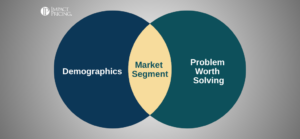Your customer’s willingness to pay is an excellent measure of your product’s value. And their willingness to pay is best estimated by the price at which you end up winning a deal/making a sale. Potential customers compare your product and price with your competitor’s product and price; they will always buy the one they believe provides the best deal for them. (The term product in this context means products, services, and all of the pieces of the offering like warranty, support, delivery, etc.)
So, how much can you charge for your product? It really depends on how much your competitor charges, and how your product is different from your competitor’s.
Value Comes From Differentiation
If your product is better than your competitor’s, the amount you can charge is the price of your competitor’s product plus the amount your customers value your product over the competing product.
Conversely, if your competitor’s product is better than yours, then you may need to charge less. Your product then appeals to price sensitive buyers who would still like to buy in your category – this is what competing on price looks like. Firms who do this usually focus on keeping their costs as low as possible in order to sustain low prices.
Using the above truths, we can see a clear conclusion: you create real value by improving your products and services relative to your competition; or, if you are competing on price, by lowering your costs (however this should be used with caution).
However, consumers don’t actually buy real value – they buy perceived value. What do they believe about your product? You may have the best product attribute in the world, but if your customers don’t know or believe in it, they won’t pay for it. Marketing is about making sure your customers perceive the value you offer. The best and easiest marketing plans make sure your customers know your real value. Essentially, build real value into your products, and communicate honestly and effectively about it.
Price Turns Perceived Value Into Revenue
Think of price as a scorecard for value: the more value you create and communicate, the higher the score. As a business person, you should spend more than 80% of your effort creating real and perceived value for your customers, and less than 5% of your time on keeping score (pricing). The other 15% is all the bookkeeping and administration behind the scenes. On a side note: a fantastic byproduct of learning more about pricing is it will point out ways you can create even more value for your customers.
Your Next Steps:
- Select one of your products and compare it to the closest competition. List all of the differences both in your favor and in your competitor’s. Be sure to include all of the extended attributes like service and warranty.
- Think of a single customer, and estimate how much the customer knows about and values the differences.
- Now, brainstorm at least 3 actions to increase your real value. Brainstorm at least 3 actions to increase this customer’s perception of your value. Do any of these actions make sense to implement for your business?















